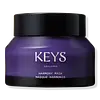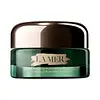What's inside
What's inside
 Key Ingredients
Key Ingredients

 Benefits
Benefits

 Concerns
Concerns

 Ingredients Side-by-side
Ingredients Side-by-side

Water
Skin ConditioningButylene Glycol
HumectantHydrogenated Polyisobutene
EmollientPEG-100 Stearate
Polysorbate 20
EmulsifyingIllite
AbrasiveHectorite
AbsorbentHoney
HumectantJojoba Esters
EmollientTrehalose
HumectantGlycerin
HumectantCharcoal
AbrasivePEG-150 Distearate
EmulsifyingGold
Cosmetic ColorantTocopherol
AntioxidantKaolin
AbrasiveSantalum Album Oil
MaskingHydrolyzed Sodium Hyaluronate
Skin ConditioningSodium Hyaluronate
HumectantXanthan Gum
EmulsifyingMica
Cosmetic ColorantEthylhexylglycerin
Skin ConditioningCaprylyl Glycol
EmollientSynthetic Fluorphlogopite
Disodium EDTA
Stearic Acid
CleansingPEG-150
HumectantPEG-150 Stearate
Citric Acid
BufferingPhenoxyethanol
PreservativeCI 77891
Cosmetic ColorantCI 77492
Cosmetic ColorantWater, Butylene Glycol, Hydrogenated Polyisobutene, PEG-100 Stearate, Polysorbate 20, Illite, Hectorite, Honey, Jojoba Esters, Trehalose, Glycerin, Charcoal, PEG-150 Distearate, Gold, Tocopherol, Kaolin, Santalum Album Oil, Hydrolyzed Sodium Hyaluronate, Sodium Hyaluronate, Xanthan Gum, Mica, Ethylhexylglycerin, Caprylyl Glycol, Synthetic Fluorphlogopite, Disodium EDTA, Stearic Acid, PEG-150, PEG-150 Stearate, Citric Acid, Phenoxyethanol, CI 77891, CI 77492
Water
Skin ConditioningBentonite
AbsorbentKaolin
AbrasiveButylene Glycol
HumectantPerlite
AbsorbentHamamelis Virginiana Water
AstringentMica
Cosmetic ColorantAlgae Extract
EmollientSilica
AbrasiveYeast Extract
Skin ConditioningPEG-100 Stearate
Charcoal Powder
AbrasiveSesamum Indicum Seed Oil
EmollientMedicago Sativa Seed Powder
Skin ConditioningHelianthus Annuus Seedcake
AbrasivePrunus Amygdalus Dulcis Seed Meal
AbrasiveEucalyptus Globulus Leaf Oil
PerfumingSodium Gluconate
Skin ConditioningCopper Gluconate
Skin ConditioningCalcium Gluconate
HumectantMagnesium Gluconate
Skin ConditioningZinc Gluconate
Skin ConditioningTocopheryl Succinate
AntioxidantNiacin
SmoothingSesamum Indicum Seed Powder
Skin ConditioningCI 77220
Cosmetic ColorantGlycolic Acid
BufferingSalicylic Acid
MaskingLactic Acid
BufferingPhytic Acid
Tourmaline
Malachite
Skin ConditioningPearl Powder
Thermus Thermophillus Ferment
Skin ConditioningCamellia Sinensis Leaf Extract
AntimicrobialCitrus Aurantifolia Peel Extract
CleansingSucrose
HumectantSpirulina Platensis Powder
Skin ProtectingTocopheryl Acetate
AntioxidantSodium Hyaluronate
HumectantCitrus Grandis Peel Oil
MaskingMaris Sal
Skin ConditioningPelargonium Graveolens Flower Oil
MaskingTrehalose
HumectantDicetyldimonium Chloride
EmulsifyingGlycerin
HumectantBis-PEG-18 Methyl Ether Dimethyl Silane
EmollientMentha Viridis Leaf Oil
AstringentCamelina Sativa Seed Oil
Skin ConditioningCaprylyl Glycol
EmollientPEG-8
HumectantSodium Polyaspartate
HumectantPolysorbate 20
EmulsifyingLecithin
EmollientSodium Methyl Cocoyl Taurate
CleansingMethyldihydrojasmonate
MaskingPropylene Glycol Laurate
Skin ConditioningPhosphatidylcholine
EmulsifyingPEG-150 Distearate
EmulsifyingHexylene Glycol
EmulsifyingPropylene Glycol Stearate
Skin ConditioningXanthan Gum
EmulsifyingJojoba Wax PEG-120 Esters
Alcohol
AntimicrobialSorbitan Laurate
EmulsifyingSodium Magnesium Silicate
Alcohol Denat.
AntimicrobialCitric Acid
BufferingParfum
MaskingCitronellol
PerfumingGeraniol
PerfumingLimonene
PerfumingLinalool
PerfumingDisodium EDTA
Potassium Sorbate
PreservativePhenoxyethanol
PreservativeCI 77288
Cosmetic ColorantCI 77289
Cosmetic ColorantCI 77499
Cosmetic ColorantWater, Bentonite, Kaolin, Butylene Glycol, Perlite, Hamamelis Virginiana Water, Mica, Algae Extract, Silica, Yeast Extract, PEG-100 Stearate, Charcoal Powder, Sesamum Indicum Seed Oil, Medicago Sativa Seed Powder, Helianthus Annuus Seedcake, Prunus Amygdalus Dulcis Seed Meal, Eucalyptus Globulus Leaf Oil, Sodium Gluconate, Copper Gluconate, Calcium Gluconate, Magnesium Gluconate, Zinc Gluconate, Tocopheryl Succinate, Niacin, Sesamum Indicum Seed Powder, CI 77220, Glycolic Acid, Salicylic Acid, Lactic Acid, Phytic Acid, Tourmaline, Malachite, Pearl Powder, Thermus Thermophillus Ferment, Camellia Sinensis Leaf Extract, Citrus Aurantifolia Peel Extract, Sucrose, Spirulina Platensis Powder, Tocopheryl Acetate, Sodium Hyaluronate, Citrus Grandis Peel Oil, Maris Sal, Pelargonium Graveolens Flower Oil, Trehalose, Dicetyldimonium Chloride, Glycerin, Bis-PEG-18 Methyl Ether Dimethyl Silane, Mentha Viridis Leaf Oil, Camelina Sativa Seed Oil, Caprylyl Glycol, PEG-8, Sodium Polyaspartate, Polysorbate 20, Lecithin, Sodium Methyl Cocoyl Taurate, Methyldihydrojasmonate, Propylene Glycol Laurate, Phosphatidylcholine, PEG-150 Distearate, Hexylene Glycol, Propylene Glycol Stearate, Xanthan Gum, Jojoba Wax PEG-120 Esters, Alcohol, Sorbitan Laurate, Sodium Magnesium Silicate, Alcohol Denat., Citric Acid, Parfum, Citronellol, Geraniol, Limonene, Linalool, Disodium EDTA, Potassium Sorbate, Phenoxyethanol, CI 77288, CI 77289, CI 77499
Ingredients Explained
These ingredients are found in both products.
Ingredients higher up in an ingredient list are typically present in a larger amount.
Butylene Glycol (or BG) is used within cosmetic products for a few different reasons:
Overall, Butylene Glycol is a safe and well-rounded ingredient that works well with other ingredients.
Though this ingredient works well with most skin types, some people with sensitive skin may experience a reaction such as allergic rashes, closed comedones, or itchiness.
Learn more about Butylene GlycolCaprylyl Glycol is a humectant and emollient, meaning it attracts and preserves moisture.
It is a common ingredient in many products, especially those designed to hydrate skin. The primary benefits are retaining moisture, skin softening, and promoting a healthy skin barrier.
Though Caprylyl Glycol is an alcohol derived from fatty acids, it is not the kind that can dry out skin.
This ingredient is also used as a preservative to extend the life of products. It has slight antimicrobial properties.
Learn more about Caprylyl GlycolCitric Acid is an alpha hydroxy acid (AHA) naturally found in citrus fruits like oranges, lemons, and limes.
Like other AHAs, citric acid can exfoliate skin by breaking down the bonds that hold dead skin cells together. This helps reveal smoother and brighter skin underneath.
However, this exfoliating effect only happens at high concentrations (20%) which can be hard to find in cosmetic products.
Due to this, citric acid is usually included in small amounts as a pH adjuster. This helps keep products slightly more acidic and compatible with skin's natural pH.
In skincare formulas, citric acid can:
While it can provide some skin benefits, research shows lactic acid and glycolic acid are generally more effective and less irritating exfoliants.
Most citric acid used in skincare today is made by fermenting sugars (usually from molasses). This synthetic version is identical to the natural citrus form but easier to stabilize and use in formulations.
Read more about some other popular AHA's here:
Learn more about Citric AcidDisodium EDTA plays a role in making products more stable by aiding other preservatives.
It is a chelating agent, meaning it neutralizes metal ions that may be found in a product.
Disodium EDTA is a salt of edetic acid and is found to be safe in cosmetic ingredients.
Learn more about Disodium EDTAGlycerin is already naturally found in your skin. It helps moisturize and protect your skin.
A study from 2016 found glycerin to be more effective as a humectant than AHAs and hyaluronic acid.
As a humectant, it helps the skin stay hydrated by pulling moisture to your skin. The low molecular weight of glycerin allows it to pull moisture into the deeper layers of your skin.
Hydrated skin improves your skin barrier; Your skin barrier helps protect against irritants and bacteria.
Glycerin has also been found to have antimicrobial and antiviral properties. Due to these properties, glycerin is often used in wound and burn treatments.
In cosmetics, glycerin is usually derived from plants such as soybean or palm. However, it can also be sourced from animals, such as tallow or animal fat.
This ingredient is organic, colorless, odorless, and non-toxic.
Glycerin is the name for this ingredient in American English. British English uses Glycerol/Glycerine.
Learn more about GlycerinKaolin is a clay. It is used for oil control and to help minimize pores. Like other clays, kaolin has the ability to absorb excess sebum or oil. This can help clean out pores and mattify the skin.
Some types of kaolin may have exfoliating properties. When water is added to kaolin, it becomes a paste with small abrasive particles.
Most kaolin is a white color, but may be pink/orange/red depending on where it comes from.
The name 'kaolin' comes from a Chinese village named 'Gaoling'. Kaolin clay comes from rocks rich in kaolinite. Kaolinite, the mineral, has a silicate layered structure. Kaolinite is formed from chemical weathering of aluminum siilicate minerals.
Besides skincare, kaolin is commonly used to make glossy paper, in ceramics, toothpaste, and as medicine to soothe stomach issues.
Learn more about KaolinMica is a naturally occurring mineral used to add shimmer and color in cosmetics. It can also help improve the texture of a product or give it an opaque, white/silver color.
Serecite is the name for very fine but ragged grains of mica.
This ingredient is often coated with metal oxides like titanium dioxide. Trace amounts of heavy metals may be found in mica, but these metals are not harmful in our personal products.
Mica has been used since prehistoric times throughout the world. Ancient Egyptian, Indian, Greek, Roman, Aztec, and Chinese civilizations have used mica.
Learn more about MicaPeg-100 Stearate is an emollient and emulsifier. As an emollient, it helps keep skin soft by trapping moisture in. On the other hand, emulsifiers help prevent oil and water from separating in a product.
PEGS are a hydrophilic polyether compound . There are 100 ethylene oxide monomers in Peg-100 Stearate. Peg-100 Stearate is polyethylene glycol ester of stearic acid.
Peg-150 Distearate is an emulsifier and thickening agent. It is created from stearic acid.
As an emulsifier, peg-150 distearate helps other ingredients dissolve. This helps prevent ingredient separation.
This ingredient may not be Malassezia folliculitis, or fungal-acne safe.
Learn more about PEG-150 DistearatePhenoxyethanol is a preservative that has germicide, antimicrobial, and aromatic properties. Studies show that phenoxyethanol can prevent microbial growth. By itself, it has a scent that is similar to that of a rose.
It's often used in formulations along with Caprylyl Glycol to preserve the shelf life of products.
Polysorbate 20 is made by combining ethoxylation of sorbitan, ethylene oxide, and lauric acid. It is a mild cleansing agent, surfactant, and emulsifier.
As a surfactant, it helps collect dirt and oils for washing. Emulsifiers prevent oils and water from separating.
Polysorbate 20 also adds scent to a product. Since it is made using sorbitol, it has a sweet scent. Sorbitol can also be found in fruits such as apples and peaches.
The lauric acid used to create Polysorbate 20 is often derived from coconuts.
Polysorbate 20 may not be fungal acne safe.
Learn more about Polysorbate 20Sodium Hyaluronate is hyaluronic acid's salt form. It is commonly derived from the sodium salt of hyaluronic acid.
Like hyaluronic acid, it is great at holding water and acts as a humectant. This makes it a great skin hydrating ingredient.
Sodium Hyaluronate is naturally occurring in our bodies and is mostly found in eye fluid and joints.
These are some other common types of Hyaluronic Acid:
Learn more about Sodium HyaluronateTrehalose is a disaccharide made of two glucose molecules (glucose is sugar!). Trehalose is used to help moisturize skin. It also has antioxidant properties.
As a humectant, trehalose helps draw moisture from the air to your skin. This helps keep your skin hydrated.
Due to its antioxidant properties, trehalose may help with signs of aging. Antioxidants help fight free-radical molecules, unstable molecules that may damage your skin.
In medicine, trehalose and hyaluronic acid are used to help treat dry eyes.
Some animals, plants, and bacteria create trehalose as a source of energy to survive freeze or lack of water.
Learn more about TrehaloseWater. It's the most common cosmetic ingredient of all. You'll usually see it at the top of ingredient lists, meaning that it makes up the largest part of the product.
So why is it so popular? Water most often acts as a solvent - this means that it helps dissolve other ingredients into the formulation.
You'll also recognize water as that liquid we all need to stay alive. If you see this, drink a glass of water. Stay hydrated!
Learn more about WaterXanthan gum is used as a stabilizer and thickener within cosmetic products. It helps give products a sticky, thick feeling - preventing them from being too runny.
On the technical side of things, xanthan gum is a polysaccharide - a combination consisting of multiple sugar molecules bonded together.
Xanthan gum is a pretty common and great ingredient. It is a natural, non-toxic, non-irritating ingredient that is also commonly used in food products.
Learn more about Xanthan Gum